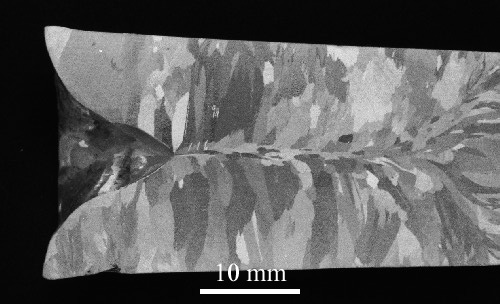Micrograph Library
Browse the libraryAdvanced searchSystemsCompositionsTechniquesKeywordsPhase diagramsHelpPreferencesAbout the micrograph libraryTerms of useContribute micrographs!FeedbackLinksCredits Print this page

Micrograph 615 and full record

- Micrograph no
- 615
- Brief description
- Cross-section of an aluminium casting
- Keywords
- alloy
 , aluminium
, aluminium  , cast, casting, chill zone
, cast, casting, chill zone  , columnar, equiaxed
, columnar, equiaxed  , metal
, metal - Categories
- Metal or alloy
- System
- Al
- Composition
- Commercial purity (99.5%)
- Standard codes
- Reaction
- N/A
- Processing
- Al melt has been poured directly into a cold mould
- Applications
- Casting is an economical process for the net-shape forming of fairly complex components, particularly large ones such as ships propellers.
- Sample preparation
- Technique
- Reflected light microscopy
- Length bar
- 10 mm
- Further information
- Solidification initiates on the mould walls because this is where the melt is coolest and because inhomogeneities promote nucleation. Selective growth then occurs, whereby the grains which have their easy growth direction <100> parallel to the heat flow direction grow fastest, and cut off the paths of less well-aligned grains. This results in a 'columnar zone' which may extend to the centre of the casting but often gives way to an 'equiaxed zone'. The equiaxed grains may result from sedimentation from the free surface, from the detachment of dendrite tips, or simply from heterogeneous nucleation ahead of the advancing front (though the latter is only likely if deliberate 'melt inoculation' has been implemented).
- Contributor
- Prof T W Clyne
- Organisation
- Department of Materials Science and Metallurgy, University of Cambridge
- Date
- 03/10/02
- Licence for re-use
 Attribution-NonCommercial-ShareAlike 4.0 International
Attribution-NonCommercial-ShareAlike 4.0 International
View image alone .. in a new window
Help is available on downloading images

